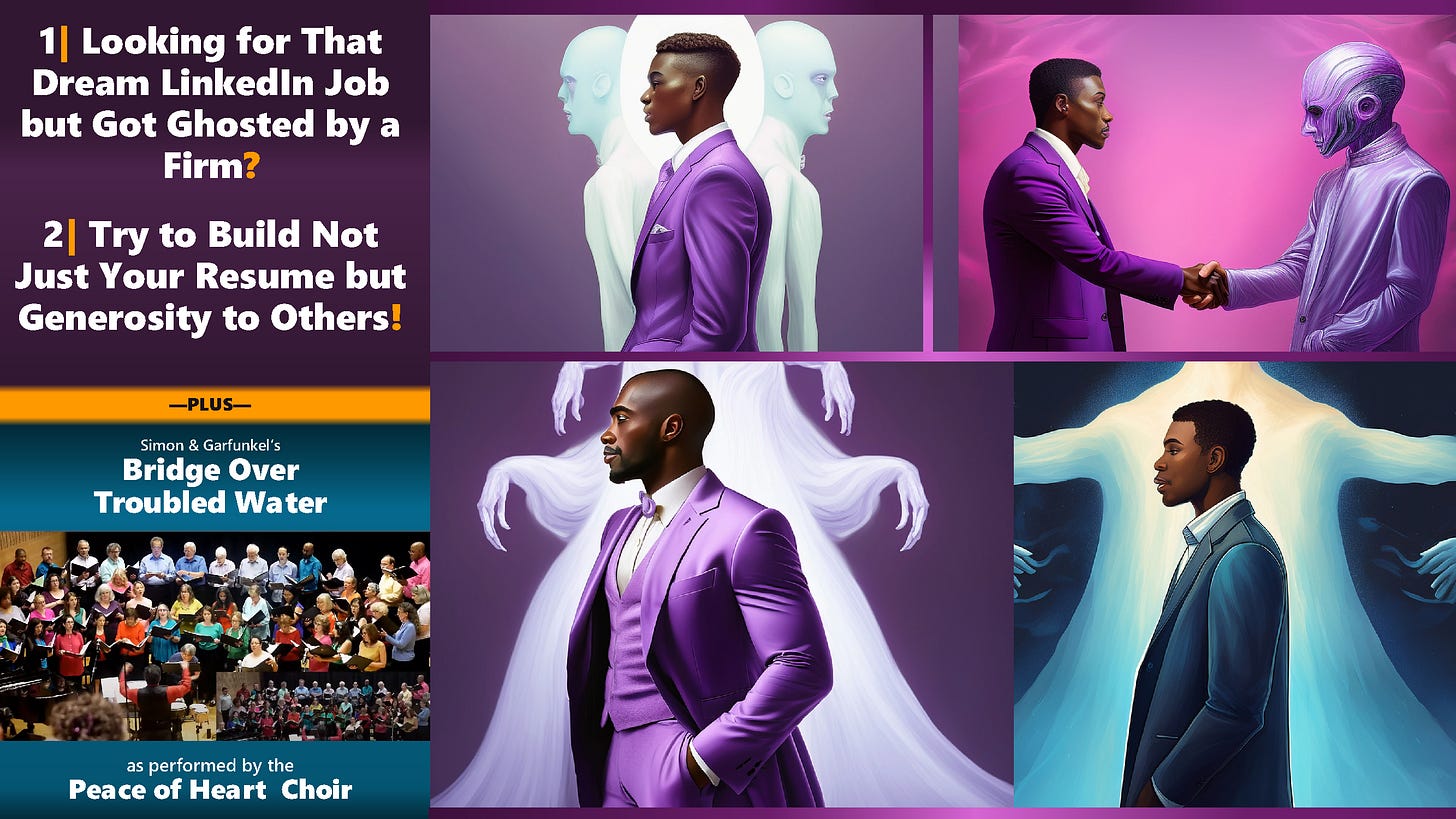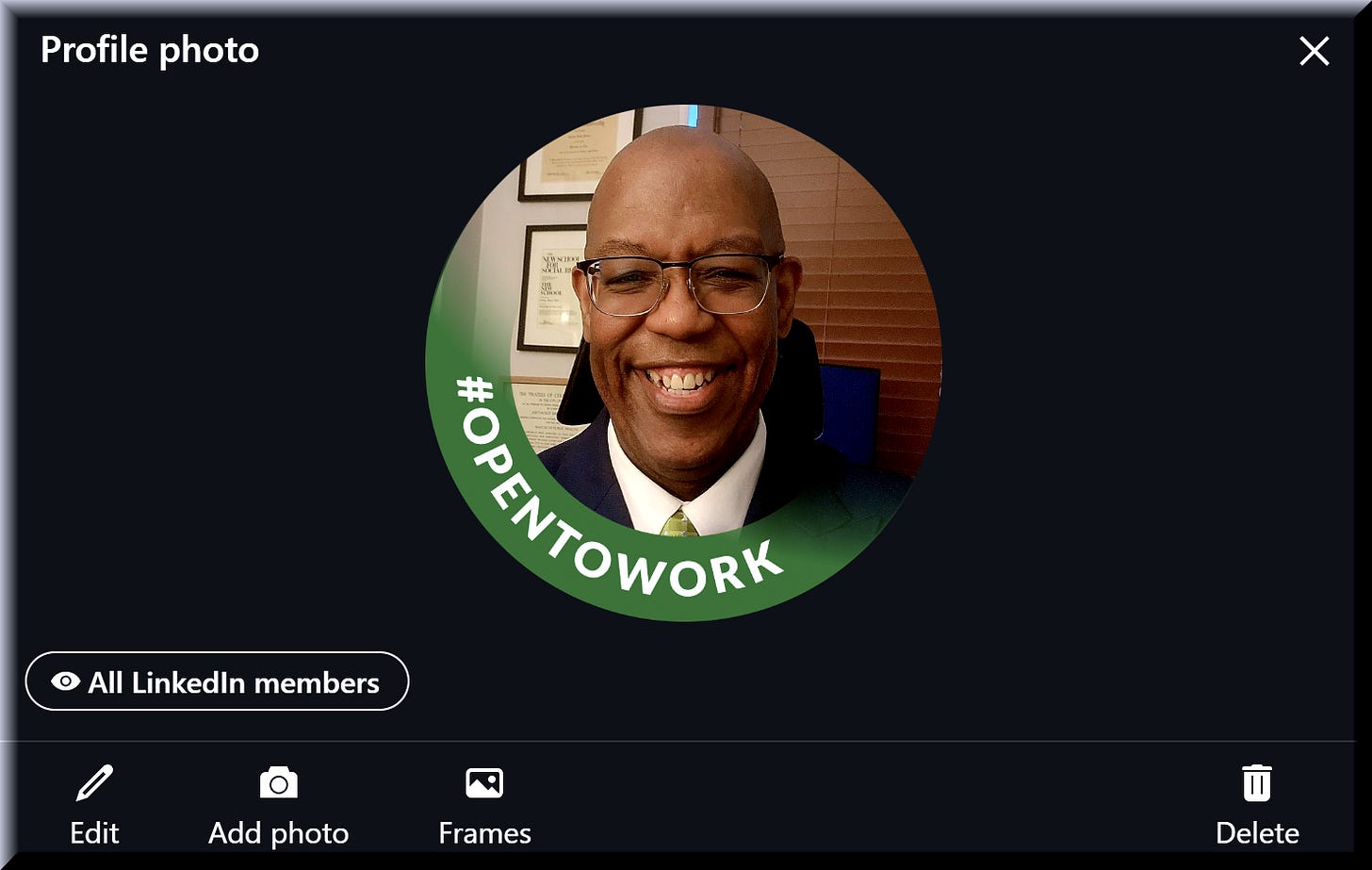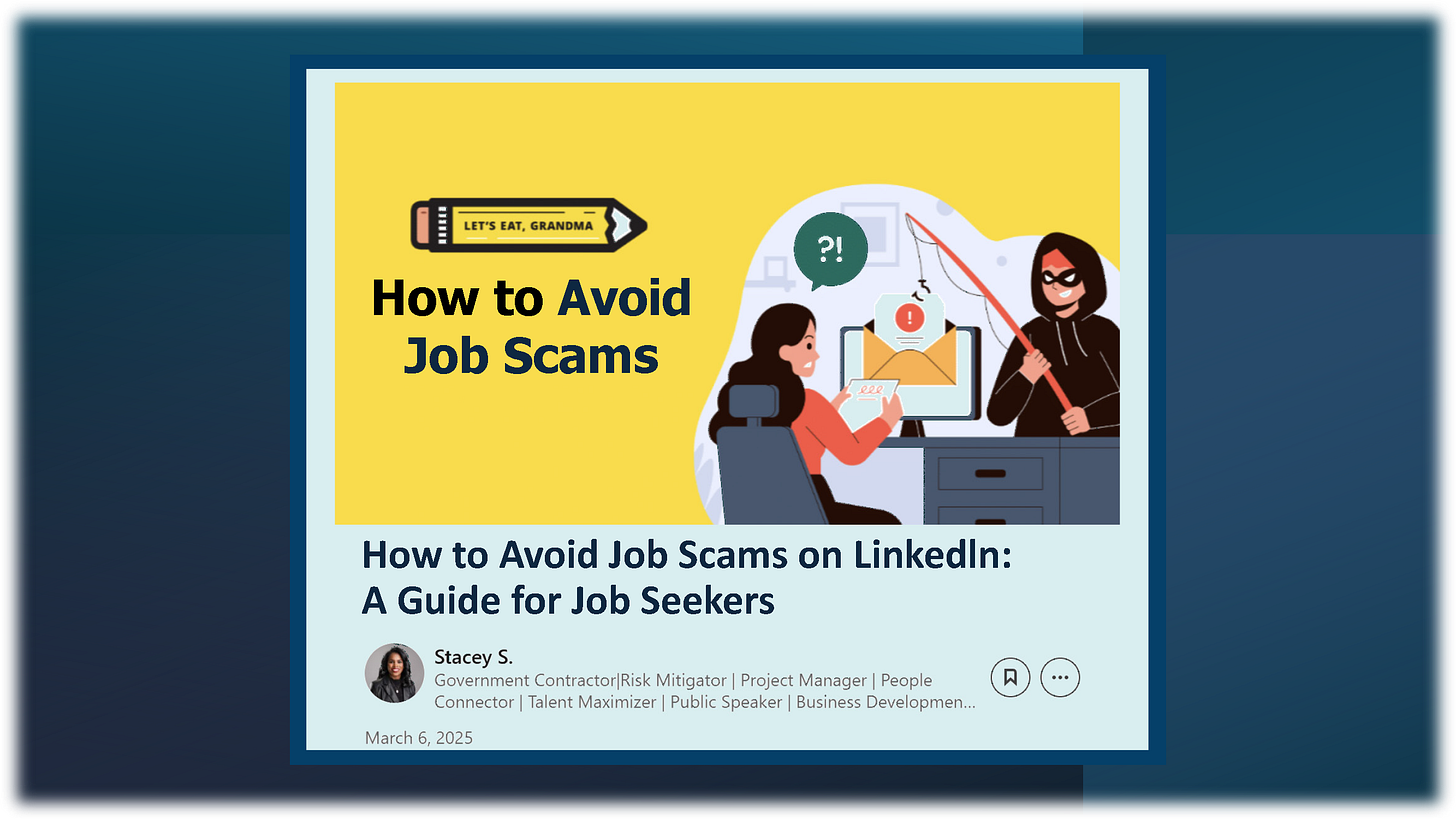1| Looking for a Dream LinkedIn Job but Got Ghosted by a Firm? 2| Try to Build Not Just Your Resume but Generosity to Others—PLUS—Simon & Garfunkel’s Bridge Over Troubled Water by Peace of Heart Choir
Firms do ghost applicants/resumes received via LinkedIn. Many list jobs solely to meet a legal publishing requisite. Don’t be ghosted. Instead, try to build a lasting rapport with Linked connections.
If you are viewing this via e-mail, then please do CLICK THE HEADLINE TITLE ABOVE to access online the MOST UP-TO-DATE and CORRECTED VERSION
Your profile is [insert superlative here]. What type of position are you looking for?
—“Fly boy” or “Fly girl” Drive-by Scam Recruiter
[E]ven submitted via LinkedIn’s “Easy Apply” button—which largely exists only to get you to ring a bell that no one on the other side of that bell will hear—most employers will never ever read your resume.
—Tony Glover, author

Ghosted Again! Pejoratively Described “DEI Hires” Need Not Apply
Anyone ever get the feeling that the job-seeking social media platform LinkedIn exists not for job seekers but for employers who want to say they reached a diverse population without hiring anyone from the diverse population that actually submits a resume?
Not familiar with LinkedIn? Then let this Perplexity description inform about how many use the platform globally:
[LinkedIn] users collectively generate around nine billion impressions each month. Additionally, LinkedIn users view more than 443 billion feed updates annually, which averages well over one billion feed views per day.
Firms advertising on LinkedIn—perhaps too many—list ostensibly unavailable job openings. Or, am I imagining that?
They then ghost those applicants who submit their resumes by never reading them because the job is in all probability close to being filled.
When you think about it, how hard is it to send even a message like one of the two below?
1. “Thanks for applying but the position is no longer open.”
2. “Or thanks for reaching out, but we hired someone via an internal referral.”
That second item above is usually the case.
My truth is this: Only *once* have I found a position via LinkedIn via an executive search firm with an established rapport with the firm that eventually hired me.
Are you presently looking?
Recently, I received sage practical guidance from the first of a series of online seminars, “Your Public Health Job Search,” organized and sponsored by the American Public Health Association (APHA) for its members. Its first session of the series focused on the importance of Networking.

Among others, the seminar featured Laura Labovich who heads The Career Strategy Group.
The strategies Ms. Labovich offered were not necessarily unknown to me. She encouraged all to focus on those firms, agencies, and/or organizations you want to work for and identify within those companies positions that suit you—even currently occupied titles. However, I was, well, taken aback when she said the following:
The average job applicant must apply for at least two hundred (200!) jobs to find one (1!) offer.
Unsurprisingly, I was, at first, discouraged by the details she provided on the strategic steps one might have to take to find what most would call their “dream job.”
In sum, Ms. Labovitch proffered that to find that dream job, one must:
Focus on 15 institutions for which you want to work
Identify 200 position titles across those 15 firms
Look to current friends, colleagues, and LinkedIn connections for help
The Vast Majority of Resume Applications Submitted Via LinkedIn Are Not Read
In all likelihood, that LinkedIn job to which you were the first to apply is remarkably close to being filled already.
Normatively, once a firm, a government agency, a non-governmental organization (NGO), and/or a community based organization (CBO) has posted to LinkedIn a job opening, that job’s status as “open” or “available” is mostly *performative* if not wholly facetious or a sham.
Why performative?
Even as a job listing is posted as “open” technically may not yet be “closed,” for all intents and purposes, the search to fill so many listings posted as “open” are nearly complete at the very moment the job is first posted on LinkedIn.
Why? Because most potential employers post a position as available/open *solely* to meet a *minimum legal requirement* that a job be *publicly* posted before a final offer is made to a candidate farther along in the hiring process to whom the employer plans already to offer the position. This is true both for union and non-union positions and for both civil service and non-civil-service positions.
Sorry to be the bearer of unwelcome news, but…
…often it does not matter whether you are the “first to apply” for a position on LinkedIn.
Indeed, according to one APHA panelist, your resume—even when it is among the first to be submitted—*likely* (not definitively) will never be looked at.
The bottom line is this:
The probability is *extremely* low 😰 you will land a job by sending to a potential employer your resume or profile info via LinkedIn.
To reiterate—
Before an opening has been listed on LinkedIn, curiously enough, that job is already close to being filled—again, usually via internal referral—by someone already working at a potential employer or by someone outside that firm who already has been targeted by the employer for hiring.
It’s Depressing but True that LinkedIn’s Premise is a Farce; Your Resume (and You) Very Likely Will Be Ghosted
I realize how depressing and eye opening it may be to know the truth that—regarding one’s ability to apply for and eventually get a job simply by submitting a resume application—LinkedIn successes are few and far between since, for many job seekers, employment opportunities hawked by LinkedIn’s member firms, consultants, agencies, and other institutions largely are built upon a house of cards.
LinkedIn Algorithms that Connect Member Firms to Member Job Seekers Like You Benefit Employers at Employee Expense
Mostly, LinkedIn—as do all social media platforms—exists to profit from the stellar credentials and accomplishments listed in your profile.
The platform also helps firms look more impressive and diverse and desirous via hired marketing teams, which post in order to make potential employers look more open to receiving you than may be the reality.
What’s the take home message here? That LinkedIn’s reason for being is as follows:
Employers who pay for the privilege can and do market a more positive side to themselves than otherwise might exist.
One more time (to drive it on home):
On many a day, LinkedIn firms neither will deign to open nor read most resumes submitted as job applications.
Beware that “Easy Apply” Button and the Recruiter Shooting Star: “Expert” Consultants Will Drive-by-Shoot You in the Dark of Night
What’s more, even when submitted via LinkedIn’s “Easy Apply” button—which largely exists to get you to ring a bell that no one on the other side of that bell will hear—most resumes will never ever be read by a potential employer.
Though I am a native New Yorker (born and raised in Gotham), I have never witnessed, in person, a fly-by, drive-by shooting. However, since I joined LinkedIn a few years back, I have witnessed so many wannabe gangsta recruiters hawking their services as charlatans.
There are so, so many!
Consider my mind blown. 🤯
Such a reality does not engender trust easily and impacts LinkedIn’s legit executive search firms and recruiters. I have learned—the hard way:
LinkedIn is *not* a place to respond to cold offers. Buyers beware: LinkedIn is head spinning! 🙃 My apologies for my pessimism but once bitten twice shy. Too many fleas on LinkedIn. [Slaps at, then scratches arm] 😏🙃🤣
Personally, whenever I surround my linked in profile picture with the platform’s ubiquitous “#OPENTOWORK” picture frame (see image below), LinkedIn’s algorithms eventually will direct to me by the score the AI-generated comments to my profile of “expert” Recruiters and Job Placement Consultants.

It seems as if only recently has LinkedIn employed algorithms warning users of possible hucksters who use the platform’s Artificial Intelligence features to generate messages or posts that seemed to target others with precision.
Despite this development, my experience is that the best advice comes not from the platform itself, but from those whose day-to-day job it might be to mitigate risk and ensure secure environments for institutions, businesses, and individuals that often have no choice but to use social media to engage others.
[As an aside: How ironic that—given the focus herein on LinkedIn consultants as posers—I reference, below, the page of a LinkedIn Consultant Risk Mitigator; alas, not everyone on LinkedIn is a charlatan.]

You can identify sham recruiters because many use the exact same nebulous, catch all language. It is non-specific and generally asks the following question:
Your profile is [insert superlative phrase here]. What type of position are you looking for?
—Drive By Shooting LinkedIn “Fly boy” or “Fly girl” poser as Job Providing Scammer
Consider the Below Sample Text to Place as Comment Below Your Posts Seeking Work
I’m grateful LinkedIn exists but, given the above, I think what I detail below might help regarding what to communicate to any of those shady recruiters on the platform (just copy and paste the text below):
(•‿•) — Are you a consultant seeking payment for your services to help find me a job?
(•‿•) — Are you a recruiter with open positions you can send me or otherwise inform me about based on your already established contracts and/or relationships with potential employers?
(•‿•) — Do refer to my profile then let me know if you presently have openings in the primary areas of expertise already detailed with clarity in my profile.
Most importantly, try to directly communicate to any suspect recruiter the following:
¯\_(ツ)_/¯ — If you offer general guidance/support requiring remuneration from me, then with apologies, I’m not in need of that.
¯\_(ツ)_/¯ — I prefer to work with recruiters paid by firms once I am placed at a firm. Is that okay with you?
On LinkedIn, It’s Not About You—Rather It’s “All about the Benjamins” Firms Spend to Advertise on LinkedIn
As used by most job applicants, LinkedIn predominantly becomes a way for others to make money off their and your accomplishments and bona fides. Too, the platform today is more about getting Linkedin members to purchase ads that boost their posts.
Additionally, the platforms AI algorithms tend to hawk to you “recruiting experts” that promise to “improve” your resume and/or help you find a position.
In short, LinkedIn tends to be “all about the Benjamins“ others will receive from you, not necessarily about easily facilitating your placement at a job.
To Find that “Dream Job,” Build Not Just Your Resume but also Your Generosity to Others
What is the best way to find that dream job?
General Guidance
Contact friends and colleagues with whom you already have established personal and professional relationships.
Focus on building new professional relationships with both current and future LinkedIn connections.
Build those relationships not based on what you want from others but on what you might be able to provide to others in support of their careers.
Step by Step Guidance
______________________________
(1)
Make a list of 15 “dream” firms for which you want to work.
______________________________
(2)
Collectively—meaning across those 15 firms, government agencies, Non- Governmental Orgs (NGOs), and/or Community Based Orgs (CBOs)—identify at least 200 job titles/positions that may not be available today but that nonetheless you would like to fill.
______________________________
(3)
For each of these firms, find at least one person (15 in total to match the 15 companies) in your LinkedIn Network of connections who either currently works or once worked at each of the 15 firms. Look at not just people listed as working at those firms but also at individuals who graduated from the same high school, college, or educational institution as you.
______________________________
(4)
Send to those 15 folks a short introductory note. Note your interest in them, *not* your job hunt. Ask what they do at their firm. Ask what their firm is like. The idea? Make the conversation not about your resume, but about the person whom you would like to get to know.
______________________________
(5)
Establish relationships not transactional in your favor but in favor of the person to whom you outreach. Perhaps volunteer, intern, or otherwise work pro-bono—i.e., for the public good.
______________________________
(6)
At the right time, one or more of those 200 positions that you identified across those 15 firms will become available, and you’ll be in a better position to apply for and secure the job.
______________________________
ONE OTHER NOTE—
I would add to the above that you should *not* solely communicate with recruiters virtually via Zoom, Teams, e-mail, phone and/or other video or audio or text based chat platforms.
Find recruitment firms and executive search firms that have brick and mortar shops that you can visit in your neighborhood, city, suburb, and/or state.
It’s best to sit with someone, pick-up on body language, note visual cues, shake their hand, and otherwise get a sense of them and their humanity (or lack thereof).
Don’t Get Discouraged!
Though it takes time, the odds are you can—and will—land one of those 200 positions. Follow the above recommendations and you just might put yourself in a better position to acquire your dream job even as what the APHA recommends sounds daunting.
Additionally, the insight provided by Risk Mitigator Stacey S. on LinkedIn—via her How to Avoid Job Scams on Linkedln: A Guide for Job Seekers post—was spot on, valuable, and kind of serendipitous as I seek to return to a career in public health as I veer away from law firms, which seemingly, by the hundreds, quickly succumbed to the federal government’s “encouragement” as federal edict that under President Trump, our nation’s largest government agencies, foundations, and both public and private institutions will no longer equitably seek out to hire Black, Indigenous and other People of Color (BiPOC).
I’m going to try APHA‘s approach and see what happens.
Good luck to each of you out there who are searching for that dream position.
Keep on truckin’ (as we used to say way back when).
It takes time, but you can find what is right for you.
A Video as Balm: Bridge Over Troubled Water by the Peace of Heart Choir
It may be hokey but nonetheless true: Those who can help are those colleagues and friends who know you best and believe in what you offer. Reach out to them.
LYRICS
When you're down and out
When you're on the street
When evening falls so hard
I will comfort you
I'll take your part
Oh, when darkness comes
And pain is all around
Like a bridge over troubled water
I will lay me down
Like a bridge over troubled water
I will lay me down




